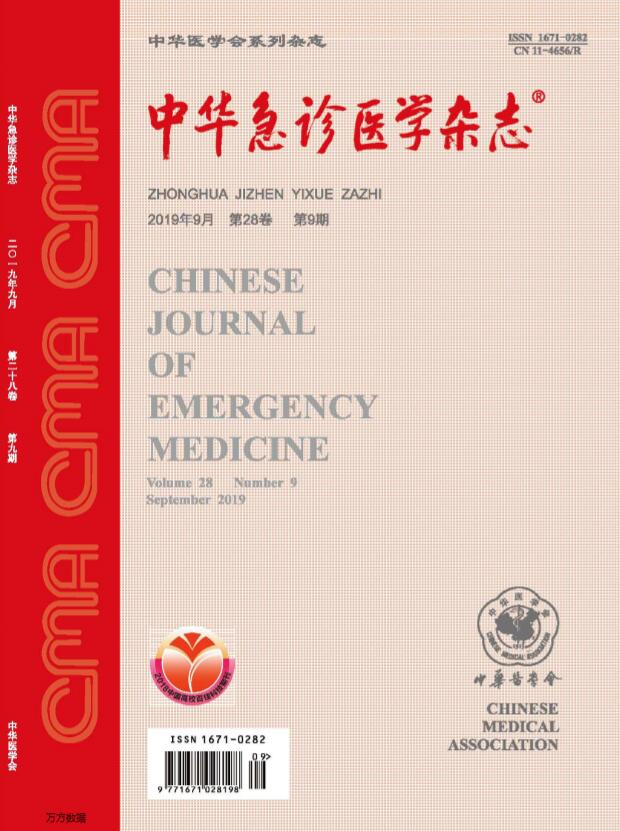Protective effect of ulinastatin on myocardial injury after cardiopulmonary resuscitation in pigs
Q4 Nursing
引用次数: 0
Abstract
Objective To evaluate the protective effect of ulinastatin (UTI) on myocardial injury after post-cardiac arrest syndrome (PCAS) of cardiopulmonary resuscitation in pigs. Methods Twelve male 3-4 months pigs were randomly divided into two groups, UTI group and control group. The ventricular fibrillation (VF) animal model was replicated by programmed stimulation method. Among the 12 pigs, 11 pigs were successfully resuscitated by CPR after 5 min VF, of which, 6 pigs were in the UTI group and 5 pigs in the control group. Immediately after resuscitation, pigs in the UTI group was given 100 kU dissolved in 5 mL normal saline with slowly injection every 3 h until 24 h after recovery (no drug was given at 24 h). In the control group, 5 mL normal saline was given with same delivery time and frequency as that in the UTI group. The venous blood of the pigs was collected at VF, 2, 4, 6, 12, and 24 h after ROCS, and tumor necrosis factor -α (TNF-α), interleukin-6 (IL-6), superoxide dismutase (SOD), malondialdehyde (MDA), and ischemia modified albumin (IMA) were measured by enzyme-linked immunosorbent assay (ELISA) method. Because IMA was sensitive and increased rapidly, venous blood was detected at 1 h after ROSC, and the rest test time were same with the rest of the blood factors. Statistical analysis was performed using LSD-t test and variance analysis. The pigs were sacrificed 24 h after ROSC, and specimens from heart tissue were taken for HE staining. Results Before ventricular fibrillation in three groups, there was no significant difference in serum levels of inflammatory cytokines, oxidative stress indexes, and myocardial ischemia markers between the two groups (P>0.05). At 2 h after ventricular fibrillation, the levels of TNF-α and IL-6 level in the UTI group was significantly lower than those in the control group. At 4 h, MDA level in the UTI group was significantly lower than that in the control group (P 0.05). HE staining results showed that the damage degree of myocardial tissue in the UTI group was significantly lower than that in the control group at 24 h after ROSC. Conclusions UTI can significantly antagonize inflammatory response, reduce oxidative stress, and improve the myocardial tissue injury after resuscitation. It can protect myocardial injury after cardiopulmonary resuscitation. Key words: Ulinastatin; Cardiopulmonary resuscitation; Post-cardiac arrest syndrome; Tumor necrosis factor -αInterleukin-6; Superoxide dismutase; Ischemia modified albumin乌司他丁对猪心肺复苏后心肌损伤的保护作用
目的评价乌司他丁(UTI)对猪心肺复苏术后心脏骤停综合征(PCAS)心肌损伤的保护作用。方法将12头3-4月龄雄性猪随机分为UTI组和对照组。采用程序刺激法复制心室颤动(VF)动物模型。在12头猪中,11头猪在VF 5分钟后通过CPR成功复苏,其中6头猪在UTI组,5头猪在对照组。复苏后,UTI组的猪立即给予溶解在5mL生理盐水中的100kU,每3小时缓慢注射一次,直到恢复后24小时(24小时不给药)。对照组给予5mL生理盐水,给药时间和频率与UTI组相同。在ROCS后VF、2、4、6、12和24小时采集猪静脉血,用酶联免疫吸附法测定肿瘤坏死因子-α(TNF-α)、白细胞介素-6(IL-6)、超氧化物歧化酶(SOD)、丙二醛(MDA)和缺血修饰白蛋白(IMA)。由于IMA敏感且快速增加,ROSC后1小时检测静脉血,其余检测时间与其余血液因素相同。统计分析采用LSD-t检验和方差分析。ROSC后24小时处死猪,取心脏组织标本进行HE染色。结果三组患者心室颤动前血清炎性细胞因子、氧化应激指数和心肌缺血标志物水平差异无统计学意义(P>0.05),心室颤动后2h,UTI组TNF-α和IL-6水平明显低于对照组。术后4h,UTI组心肌组织MDA含量明显低于对照组(P<0.05),ROSC后24h,HE染色结果显示UTI组的心肌组织损伤程度显著低于对照组。结论UTI能显著拮抗炎症反应,减轻氧化应激,改善复苏后心肌组织损伤。它可以保护心肺复苏后的心肌损伤。关键词:乌司他丁;心肺复苏;心脏骤停后综合征;肿瘤坏死因子-α白细胞介素-6;超氧化物歧化酶;缺血修饰白蛋白
本文章由计算机程序翻译,如有差异,请以英文原文为准。
求助全文
约1分钟内获得全文
求助全文
来源期刊

中华急诊医学杂志
Nursing-Emergency Nursing
CiteScore
0.10
自引率
0.00%
发文量
8629
期刊介绍:
Chinese Journal of Emergency Medicine is the only national journal which represents the development of emergency medicine in China. The journal is supervised by China Association of Science and Technology, sponsored by Chinese Medical Association, and co-sponsored by Zhejiang University. The journal publishes original research articles dealing with all aspects of clinical practice and research in emergency medicine. The columns include Pre-Hospital Rescue, Emergency Care, Trauma, Resuscitation, Poisoning, Disaster Medicine, Continuing Education, etc. It has a wide coverage in China, and builds up communication with Hong Kong, Macao, Taiwan and international emergency medicine circles.
 求助内容:
求助内容: 应助结果提醒方式:
应助结果提醒方式:


